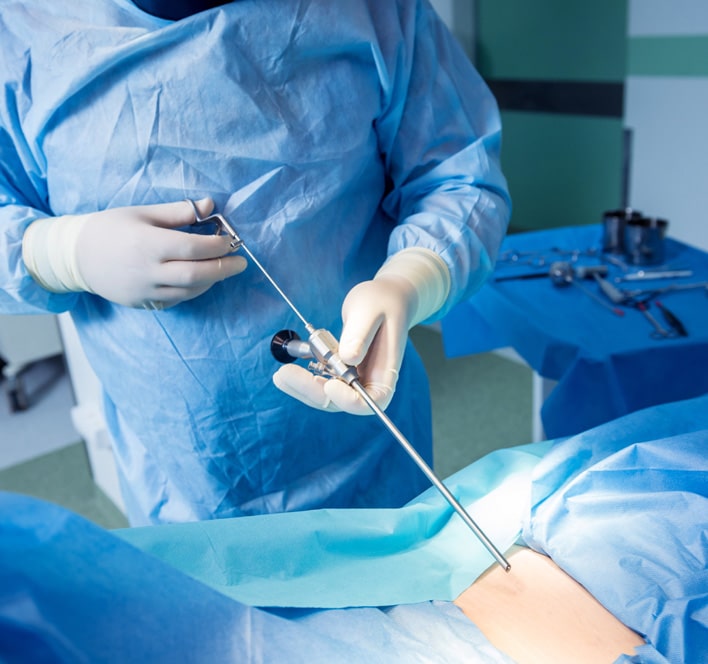Many spinal conditions can cause back pain and symptoms that can be relieved by traditional treatments. However, if your condition progressively worsens, conventional treatments may not bring you the relief you need. In this case, your orthopedic doctor may recommend other options, such as surgery.
An orthopedic spine surgeon at NJ Spine & Orthopedic can perform a discectomy for various spinal conditions if traditional treatments no longer work. Learning what an endoscopic discectomy is, along with the relief that it can give you, can give you the peace of mind you may need to move forward with treatment. Our Concierge Team are wonderful patient advocates and can also help you through every aspect of the treatment process.
The Difference Between an Open Spine Discectomy and an Endoscopic Discectomy
For an open spine discectomy, the surgeon will make an incision along the midline of the lower back and then spread the muscles to the side to access the spine. Next, the surgeon removes the vertebral arch on the spine as necessary. To reach the herniated disc, the surgeon has to move the nerve root out of the way. Now, the surgeon can remove part or all of the disc protrusion causing the problem.
Spine surgeons perform an endoscopic discectomy using an HD camera connected to an endoscope. This tool helps the surgeon get a close-up view of the area of the spine that needs to be repaired. A small incision is made as a conduit for the endoscope and surgical instruments required to perform the discectomy.
Endoscopic discectomies have a much higher success rate than open spine discectomies because less soft tissue injury lowers the chance of infections. An added benefit is that it takes a shorter time to do an endoscopic discectomy. This means that surgery can often be done as an outpatient procedure, and you may be able to go home that same day.
Conditions That an Endoscopic Discectomy Can Treat
Conditions you may have that could require an endoscopic discectomy are:
- Bulging and herniated discs
- Degenerative disc disease
- Failed back surgery syndrome
- Sciatica pain
- Radicular pain
Bulging, slipped, ruptured, or herniated discs are the most common condition that discectomies repair. A disc with cartilage on the outside protects a gelatinous inner core. When the inner core escapes the confines of the cartilage, this condition is referred to as a bulging or herniated disc. Because space is limited in the spine, this unexpected protrusion can create pressure on nerves or the spinal cord, causing moderate to severe pain.
Degenerative disc disease makes it easy for discs to herniate. The outside of discs is made of cartilage. When the cartilage becomes weakened or fragile due to degenerative disc disease, the inner cores can easily protrude or bulge outside the disc’s confines.
Sciatica is a nerve that starts in the lower back and runs down each leg. When a herniated disc puts pressure on this nerve, the result is sciatica pain. Radicular pain radiates from your back and into your legs through the spine. Numbness, tingling, and muscle weakness can accompany the pain. The pain originates through the spinal nerve root that a herniated disc can aggravate.
What Are Endoscopic Discectomy Recovery Expectations?
Recovery after an endoscopic discectomy is much quicker than an open spine discectomy. If you follow your doctor’s instructions, you should be feeling far less back and leg pain than before the surgery in no time.
Nerves take time to heal, so you may continue to feel numbness and tingling in the limbs affected by the herniated disc before the surgery. In addition, your doctor may prescribe physical therapy to strengthen your back and abdominal muscles to prevent further injury to the area and to increase your motion range.
You should be back to work within one to six weeks, depending on your specific circumstances. For example, if you work in an office, you could return to work in one or two weeks. However, if your activity at work is more mobile, with lifting and bending, you may have to wait four to six weeks since patients are advised to refrain from bending, lifting, and twisting for a few weeks after the surgery.
Contact the Orthopedic Surgeons at NJ Spine & Orthopedic for Your Endoscopic Discectomy
If you have a worsening spinal condition and traditional treatments are not working, the orthopedic spine surgeons at NJ Spine & Orthopedic can help provide relief by performing an endoscopic discectomy. This minimally-invasive surgery can help relieve your pain and get you back to work or participating in your favorite activities sooner rather than later.
The orthopedic spine surgeons at our office specialize in minimally invasive endoscopic discectomies. Call us at (866) 553-0612 or complete our contact form if traditional treatments cannot relieve your chronic pain or restore your range of motion.

